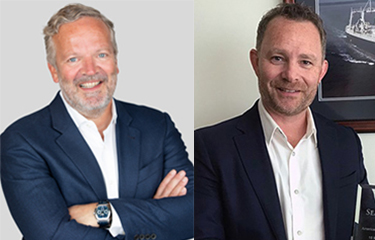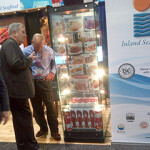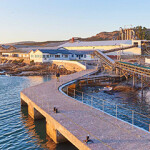American Seafoods’ Einar Gustafsson, Rasmus Soerensen talk M&A, pricing, strategy shift

Einar Gustafsson is the CEO and Rasmus Soerensen is the chief commercial officer of Seattle, Washington, U.S.A.-based American Seafoods, one of the world’s largest at-sea processors of Alaska pollock and Pacific hake. Both were appointed in February 2022. Earlier this week, Bregal Partners announced it would commence a sale process of its holding in the company.
SeafoodSource: How has your first year at the company gone?
Gustafsson: I joined the company in March 2022. Since then, we have refocused our strategy to be focused on being a fishing company and trying to be the best that we can be and be a good supplier to our customers. We don't want to compete with our customers, we want to partner with our customers so we do the fishing and they do the processing and value-added, and that seems to work well. Secondly, we are looking for growth opportunities, both in terms of building a new vessel, which is in early stages still. We have had to have a preliminary design done and we’re looking at some financing and shipyards. Obviously, it is challenging given the U.S. regulations to do this. We are actively looking at M&A opportunities and have built up a few, primarily focused within our area of competence, within our sector, not necessarily pollock fishing, but within the fishing sector both here domestically and abroad. We are being very careful about what we want to buy and we want to do. I inherited a very strong company with a very strong balance sheet, so we have firepower, but I want to use that carefully. Overall, we are pretty optimistic. Markets are good. Business is good.
SeafoodSource: Can you provide any more insight into how you developed this new strategy?
Gustafsson: Some people say there is some value in vertical integration. And it may be true that you control your destiny, you control your materials through the supply chain, you have an end-to-end solution for your customers. But I don't believe in that personally. So, I think we are very focused on what we do. We used to have a value-added operation on the East Coast many years ago, that was not very successful and we exited that. I think it’s quite important to stick to basics. So, we went to a bit of a strategic review and we concluded we would focus on what we're very good at, which is high-volume fishing, primary processing type of operation.
SeafoodSource: Can you provide an overview of the company's financial situation?
Gustafsson: We have a very strong balance sheet. In the past seven years, we've paid down an enormous amount of debt and have quite a low leverage ratio. I can't get into specifics but we are clearly well-positioned to both continue to invest in our business, whether it's in the acquisitions – M&A-wise – new-builds, or existing vessels. I think the company has never been as strong as it is now, in its history, from a balance sheet point of view. We can hold inventory, we’re well within all covenants, we’ve got excess headroom on lines. The biggest challenge is I can’t mess it up. [Previous CEO] Mikel [Durham] did a phenomenal job of driving discipline and that paid off in a number of ways. We need to treat this asset with respect and make sure that we invest wisely.
SeafoodSource: How do you feel about the status of your vessels and how close are you to embarking on a fleet-renovation program?
Gustafsson: Our vessels are not young, but they're not old. We have done an exceptional job of maintaining and investing in the vessels. So, the opportunity to build a new one or renew the fleet is more an opportunistic thing than a result of obsolescence. So, the question is, can we do something that results in a more-efficient vessel, new product forms, like that can add to the market. In the meantime, we continue to maintain our vessels very well. I think we’re in good shape, but it is challenging and we have to proceed very carefully. We got to make sure that the numbers stack up. We as an industry are looking at trying to learn from each other in terms of how to best do this and what to deal with and it really is a challenge. So, we’ve got to proceed very carefully.
SeafoodSource: How has the fishing and demand been this year?
Soerensen: Pollock A season is done, it was good fishing. A little bit lower yield than we expected but better pricing and record fishing. In general terms. Alaska pollock is in a very good position in the global markets. We came through a pandemic, where operationally we and the entire industry had a lot of challenges, but from a market standpoint, it was all upside. There was plenty of demand for our products on all fronts. When the pandemic hit and foodservice shut down pretty much all over the world and all consumers started flocking more to the supermarket and became more adventurous within the supermarket, frozen fish benefited tremendously from that. More consumers came into the category. They were a little bit more willing to try new things. And even coming out of the pandemic, we've seen a lot of those new consumers stay with seafood, so that's been a very positive development. We had last year a 19 percent drop [in supply] in our quarter which of course immediately had a quite profound impact on pricing for all our products because we were going through a time of very high demand for everything we produce on our vessels, and all of a sudden we have almost 20 percent less supply. So that had an impact and consequently everything frozen off our vessels went to historical high prices in the second half of 2022. TACs are correcting, we are nudging back in towards more normal level at 1.3 million tons this year, so it's 14 percent up again. With more supply coming into a market situation that is now adjusting again coming out of the pandemic, there is a slight imbalance between supply and demand. So, we are seeing prices adjusting which is not unusual when they go up, there's usually an adjustment afterwards. We're starting to see them plateauing and we're still at very healthy pricing for all products coming out of the pandemic coming out of a low TAC year.
SeafoodSource: Where is the market for Alaska pollock thus far in 2023?
Soerensen: I think that's fair to say prices were getting a bit too high last quarter, and were rising too fast, that was a reaction from the market. We like stability and a healthy demand and when prices rise too sharply, too fast that’s not good for anybody. To give you an example, a lot of our customers have a little bit more inventory now than they have been used to the last couple of years. And when you didn't have a price correction, that means your inventory is now too expensive. Look what happened to the snow crab. So, there is a mechanism there the industry and the market actually have a keen interest in keeping things relatively stable. Now of course, there’s adjusting for inflation rates and all that, but these big swings in the marketplace is not a good thing.
We also don't sell on the spot price. We believe …
Photos courtesy of American Seafoods




Share